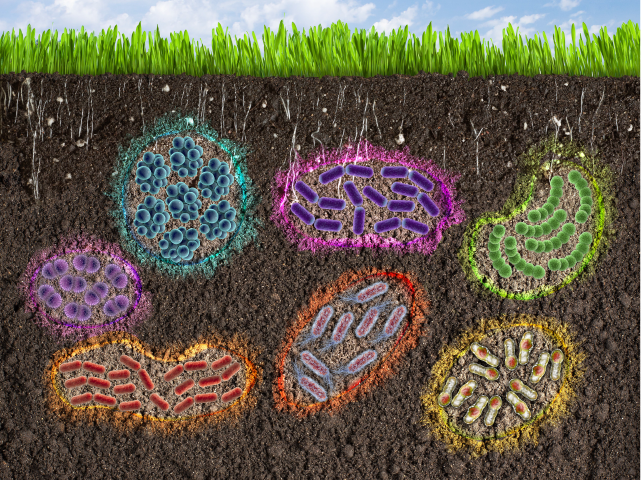Environmental Transformations and Interactions
Like a Traffic Light, Biofilms Direct Water Movement in Soils
Ultrathin biofilm layers can speed, slow, or hold up the movement of water in soil pores.

The Science
Microbial communities in soils sometimes form an ultrathin film to protect themselves from their environment. But the growth of these biofilms can affect the environment itself, changing, for example, how water moves through the soil. Computer models can predict changes in the biofilm and the environment around it. Now, for the first time, scientists have been able to couple these models with observations of biofilms in the laboratory to show more clearly how they change the movement of nearby water through the soil.
The Impact
Like a traffic light, biofilms can direct how water moves through soil, causing it to speed, slow, and even stop in places. These kinds of changes can influence the movement of nutrients and the chemistry of the soil. Understanding these changes is key to the success of many industrial applications, such as bioremediation of contaminated groundwater, storage of carbon dioxide underground, and exploration of new sources for oil and gas. Carefully planned experiments can verify and validate models, allowing scientists to make better predictions of how these biofilms will affect the environment.
Summary
To evaluate the impact of biofilms on the movement of water underground, a multi-institutional team of scientists used a two-dimensional computer model to simulate the presence of biofilm in the soil. At EMSL, the Environmental Molecular Sciences Laboratory, a DOE Office of Science User Facility, they also grew biofilms experimentally among cylindrical grains in a microfluidic chip. They then digitized the images of the experimental biofilms and simulated water moving through the geometric formation. This was the first time that observations had been used to inform model development. Using this one-two punch approach, the scientific team discovered that biofilms played an even bigger role than expected in shaping how water moved. For example, when a biofilm was present, water could either speed through the soil or be retained within it for longer than expected periods. It might also spread farther than in soils without a biofilm. These findings could help other scientists and managers factor the growth of biofilms into the design of engineered systems in soils and in the deeper subsurface.
Contacts
- Lazaro J. Perez, Desert Research Institute, lazaro.perez@dri.edu
- Andrew Plymale, Pacific Northwest National Laboratory, andrew.plymale@pnnl.gov
Funding
Funding for this work was provided by the DOE Office of Biological and Environmental Research program. Experiments were performed at EMSL, the Environmental Molecular Sciences Laboratory, a DOE Office of Science User Facility.
Publication
L.J. Perez, et al., “Contributions of biofilm-induced flow heterogeneities to solute retention and anomalous transport features in porous media.” Water Research 209, 117896 (2022). [DOI: https://doi.org/10.1016/j.watres.2021.117896]
Related Link
Original paper on the strain of bacteria used: https://journals.asm.org/doi/10.1128/AEM.01844-12

